Propagating garlic is very straightforward. Where I get hung up usually has to do with deciding how many cloves to spare from the kitchen knife to plant back out.
And I love these tasty flavor bombs, so it’s a battle between the taste buds of the present and future.
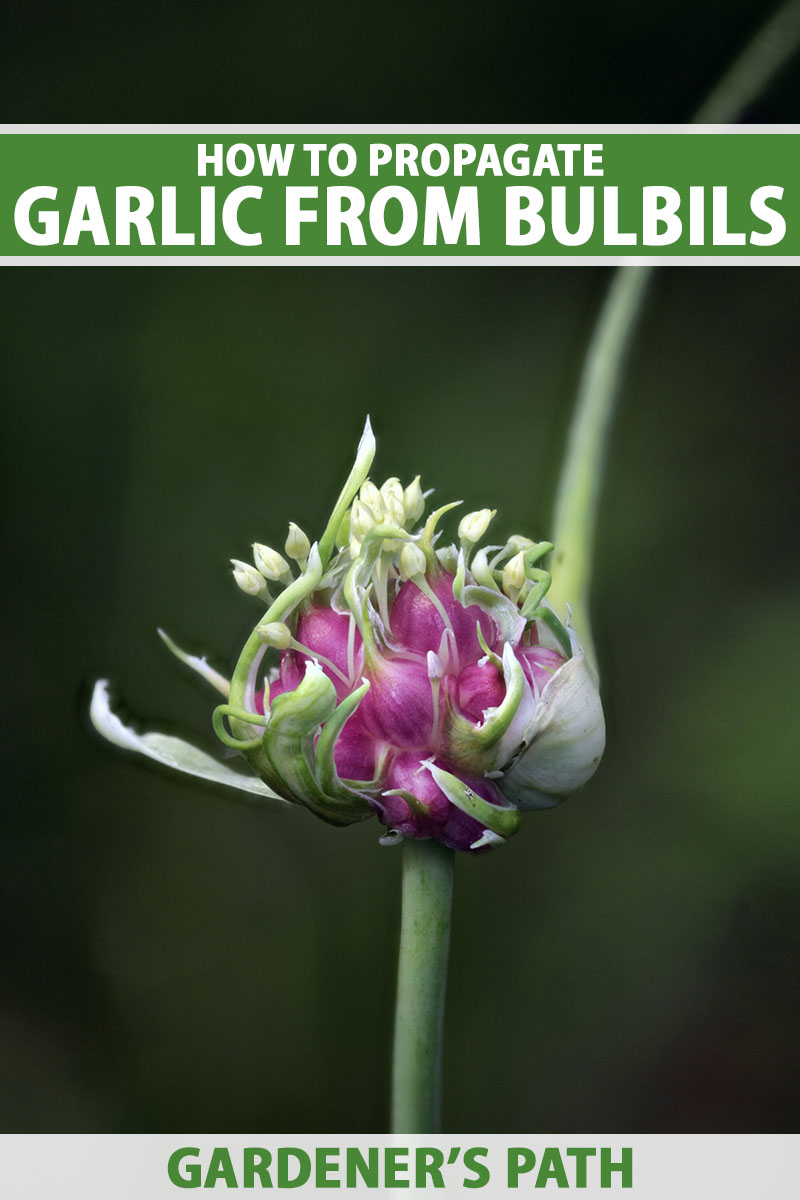
We link to vendors to help you find relevant products. If you buy from one of our links, we may earn a commission.
Sure, every year the number of cloves you end up with increases, but it’s not by a lot, and it can take a long time to significantly increase your planting stock without buying more seed garlic.
That’s where the bulbils come in. Leave a few scapes alone and you’ll end up with ten to 100 tiny aerial cloves from each one to plant in your garden in the fall.
How does this type of propagation work and where do you start?
Read on to find out!
This is what we’ll cover:
What You’ll Learn
What Are Garlic Bulbils?
You know those delicious scapes that sprout from your hardneck garlic each spring?
If you leave them be, rather than cutting them to use in pesto or stir fries, each one will eventually produce an umbelliferous bloom. In the late summer and early fall, the scapes will produce mini cloves known as bulbils.
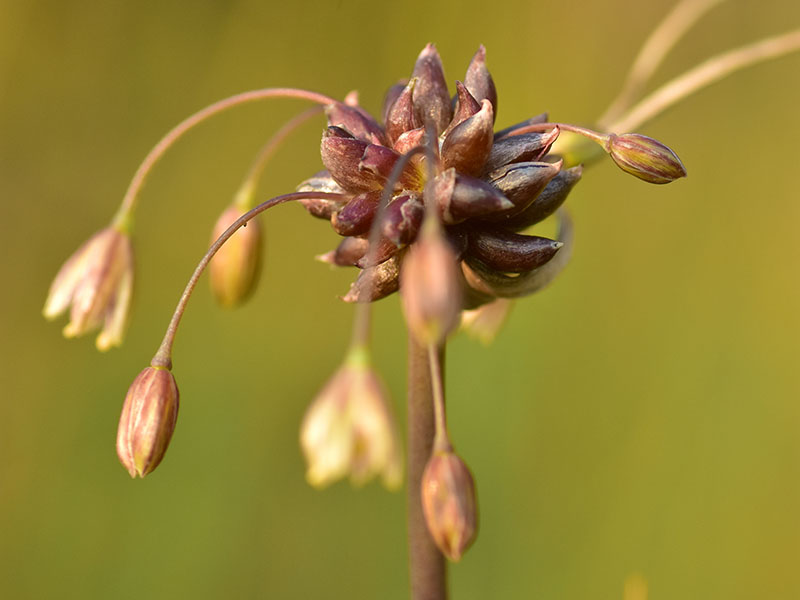
These little guys can be collected and either eaten – although it’d take a lot of the rice-grain-to-pea-sized bulbs to flavor a given dish – or planted out like seed garlic.
Bulbils, or bulblets, are not seeds produced via sexual reproduction. Scapes are not true flowers, and their reproductive parts only form partially – so they aren’t viable, and there’s no cross-pollination involved here.
Each one is a clone of the parent that offers a different way for the plant to vegetatively propagate, as is dividing your bulb harvest into cloves that you’ll replant.
However, that method only yields four or five underground cloves each, while each scape can produce 10 to 100 of these mini aerial bulbs – and you can sow all of these out.
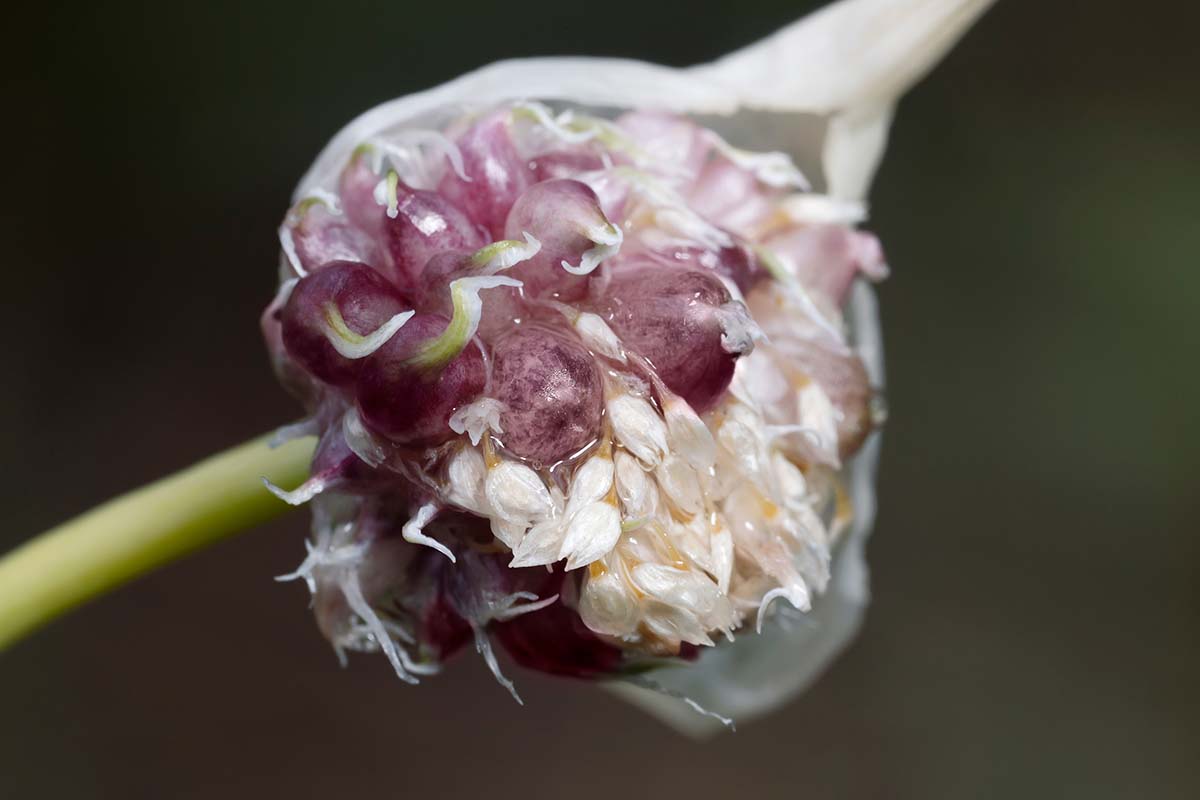
Not only are they free of any soilborne diseases that may be present in the ground-grown seed garlic you’d normally put back into the garden in the fall, but you can increase your planting stock much faster than if you’re saving soil grown cloves to plant out.
It’s worth sacrificing two or three scapes worth of pesto for that, in my opinion!
Note that softneck varieties not form scapes so this propagation method can only be used with hardneck types, like ‘German White.’ You can learn more about the different types of garlic in our guide.
Collection and Storage
Once the bulbil pod develops a crack, cut the entire scape and hang it to cure in a protected, well-ventilated area.
You’ll know they’re sufficiently dried when there is no green left on the scape, and the stem and outer layers are brown and crispy. This can take about a month, so be patient!
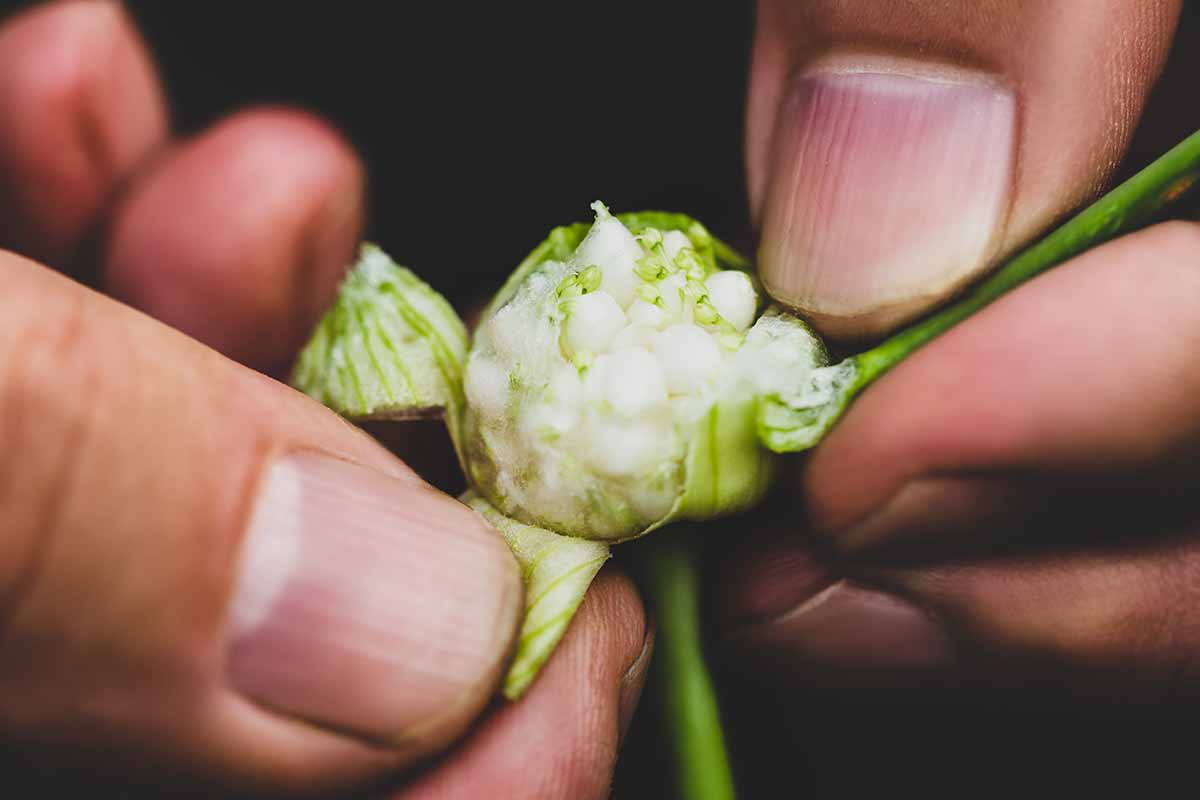
Once they are dried, break the pod open the rest of the way and rub with your finger to remove the bulbils. They should easily drop off when they’ve dried and cured sufficiently.
Store in a cool dry place until you are ready to plant them out.
Planting and Harvest
Add these to your garden as you would regular seed cloves. Plant them out in the fall with their wrappers intact, in a mulched, weed-free bed. You can also root them in containers filled with sterilized soil or potting mix.
The only marked difference between sowing seed cloves and bulbils has to do with planting density.
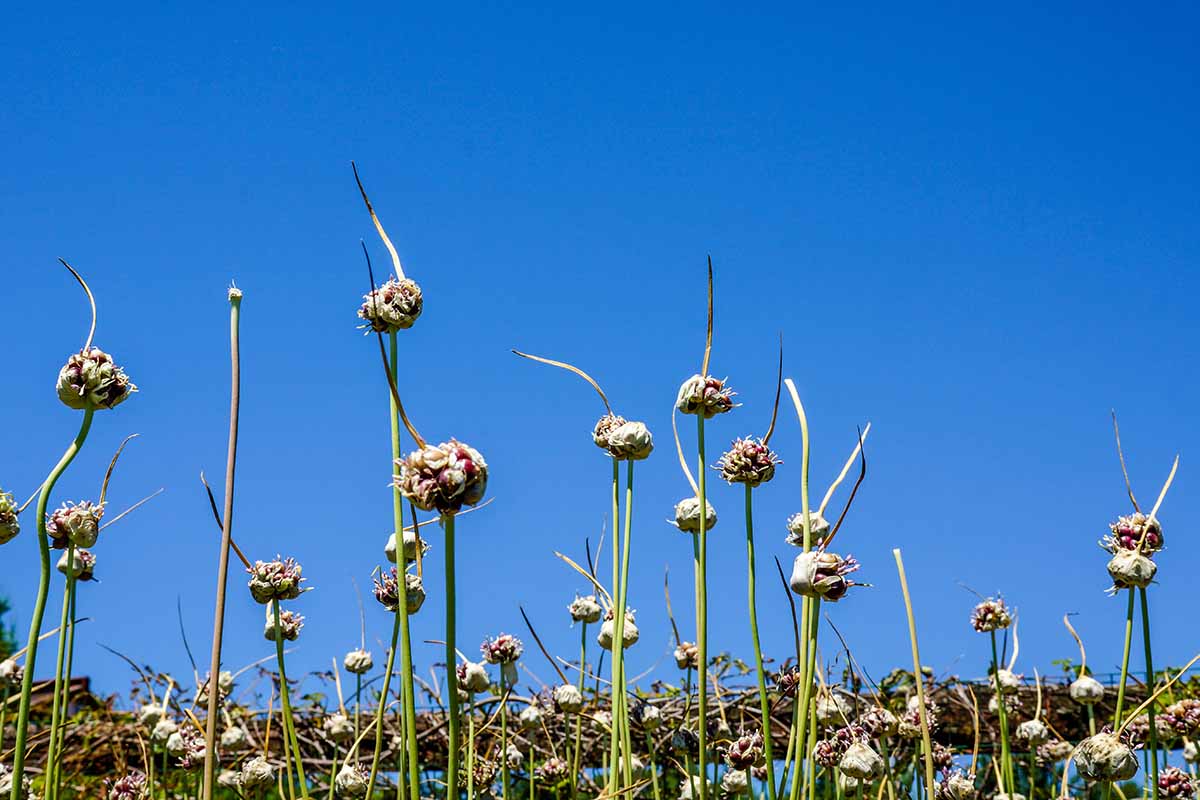
Since these are so small and won’t grow as large as a full clove does in one season, leave six to eight inches between rows. Place the larger ones four inches apart, and smaller ones can be planted two inches apart.
Different varieties produce bulbils of different sizes, so be mindful of this and plant appropriately.
They will emerge in April or early May and will be ready to harvest when the bottom leaves turn yellow and the stems flop over.
Gently pull them from the ground. The resulting roundels (or single cloves) are not as strong as those produced from planting a full-sized clove, so be careful! You want the stem to remain intact so you can hang them to dry.
Just like the bulbils, these roundels will need to be cured, so hang them in a cool, dry location as you did with the scapes originally. You can learn more about the process of curing garlic in our guide.
Replant the individual roundels in the fall, providing increased spacing as needed depending on their size.
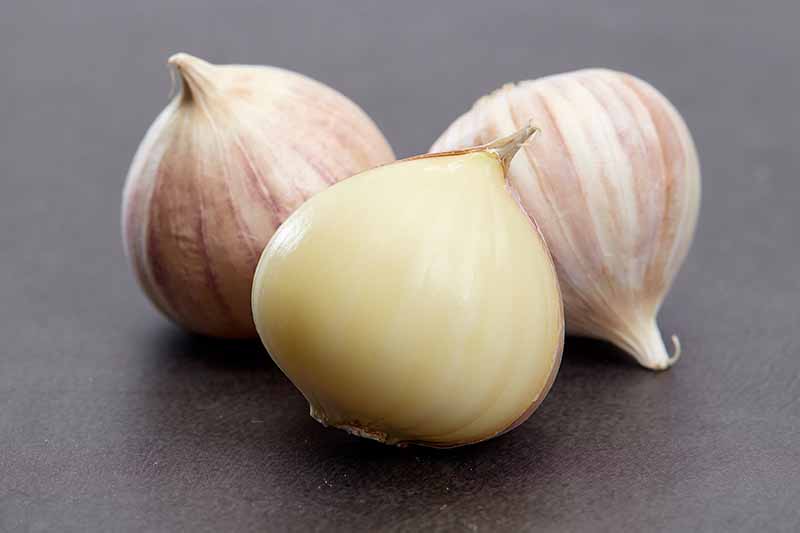
It can take two to five years, depending on their size and the local conditions, to go from bulbil to a full-sized crop that you can harvest and use in your culinary adventures.
But just imagine how much garlic you’ll have down the line, propagated for free!
From Mini to Major Harvests
Garlic, especially more garlic, is always a good idea. But I always struggle with the internal battle between wanting to have enough to eat over the winter and wanting to ensure an abundant crop next year.
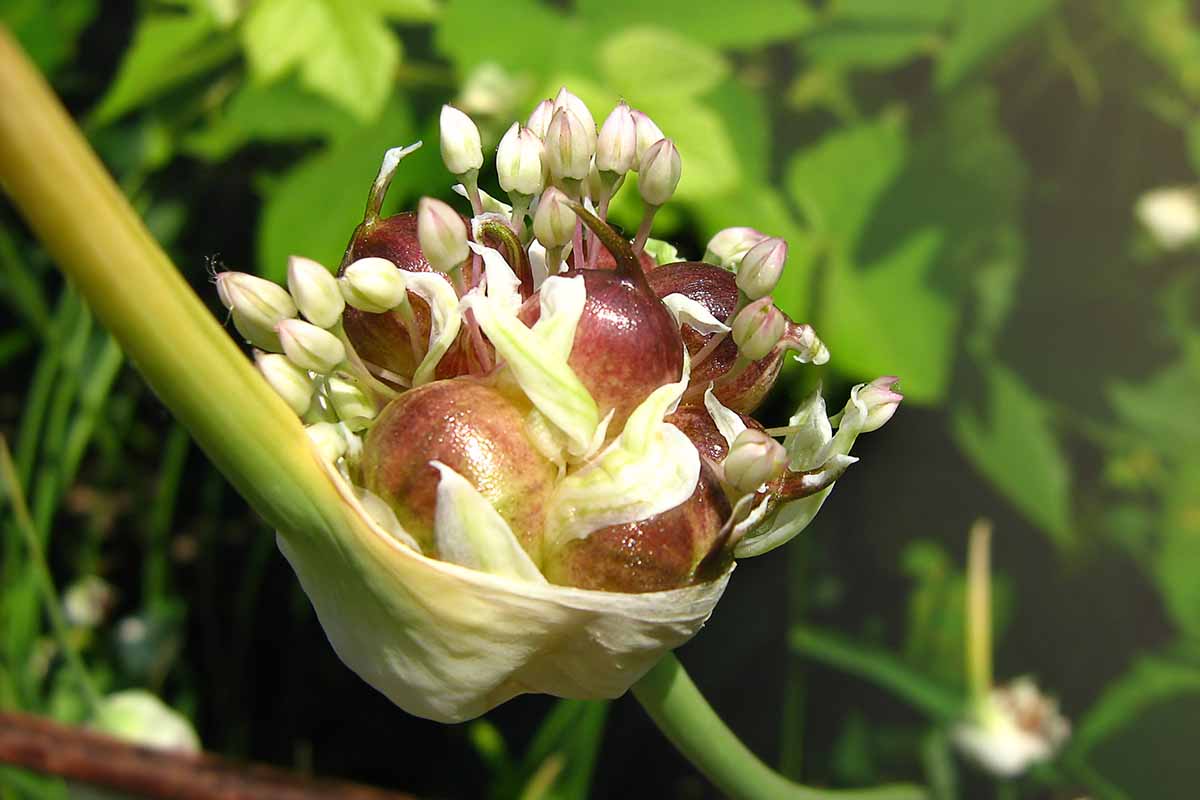
The solution to increasing planting stock without buying more seed cloves is to leave a few scapes to produce these aerial cloves, and they’ll be disease-free, no less!
Sure, it takes longer to get a usable crop with this propagation method. But within a few years, you’ll have more than enough to eat and to plant out for an abundant harvest the next year.
Have you ever noticed bulbils on scapes you’ve left to flower? Let me know if you’re planning to plant them this year in the comments below!
In the meantime, read these helpful garlic-growing articles to aid you in your quest:
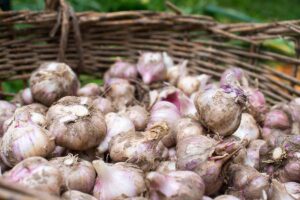


I let one of my hard neck garlic flower. The other scapes I removed from the other garlics flowered as well. I’m still confused on when to cut off flowers, and how to plant them.
If you want to propagate bulbils, they need to be allowed to develop fully so the flowers must be left in place. Like the seeds of other types of flowering plants, these tiny seed cloves form after the flowers are pollinated and then die back. Only hardneck varieties of garlic will produce these. The bulbils will be left in the blooms’ place in late summer or early fall, inside the remaining pod at the end of the scape that will begin to dry out and develop a crack. Follow the tips provided above in our article for drying and planting,… Read more »
While my bulbils have started to open I’m usure if I should harvest and dry now or wait.This is my first attempt planting garlic and my only knowledge of my garlic is that I received 100 transplants from my sister that lives 50 miles away in May with about 12 surviving our summer in NE Wi which had a mild drought this summer.
Yes, if they have opened and begun to dry, this would be prime time to collect the bulbils before they scatter on their own.
I’m house sitting and was told to go ahead and pick the garlic. I’ve never seen this type before, but I pulled them out and rubbed these off the top “globes.”
Are these edible? Could I plant these in house pots? Thanks
These appear to be bulbils, like this article describes!
I just harvested my bulbils and I live in Upstate NY. Should a plant the bulbils in pots or direct to the soil? Do I have to harvest and plant in the fall like the regular garlic seed?
Hello, Micheline in upstate New York. That’s an impressive harvest!
You can plant those bulbils in late fall the same way you would other seed garlic, following the directions in this guide. The main difference is that you can space them a little closer together, leaving four inches between larger bulbils and two inches between the smaller ones.
I hope it goes well and that you keep us posted.
My name is Tim (Ogre)….this past year was the first time I had a really good crop of garlic. (Music, Killarney, German Red) and I sold them at a local farmers market. My customers have come up to me since then can tell me they can’t wait to get more. I am going to try planting the bulbils this fall and see what happens. I am in the Willamette Valley area of Oregon. Thank you for the information in the above article. Will keep you advised…
Hello Tim. It’s great to hear of your success, and I’m anxious to hear how the bulbils fare in your fall garden. Please say hello to our fellow gardeners in the lovely Willamette Valley, and thanks for reading!
Just out of curiosity I let some of my scapes go last year and truly didn’t know what I was doing, but so thankful for what I have learned this year in the process. I have nine bulbils coming up and plan to do more this year so I have the quality and quantity I will need down the road. Thank you for this article, it will be a great resource to refer to.
Thanks for reading Arlene and good luck with your baby garlics!
Good morning this is my first go round at growing garlic. I have six plants and the bulbis has flowered and the tiny bulbs are in there so if I’m reading correctly, I cut them off now and hang them for a month and then plant them. But are they good for next year or do I have to wait five or six years? . I got a little confused. Anyways, I loved the article and appreciate your time and effort.